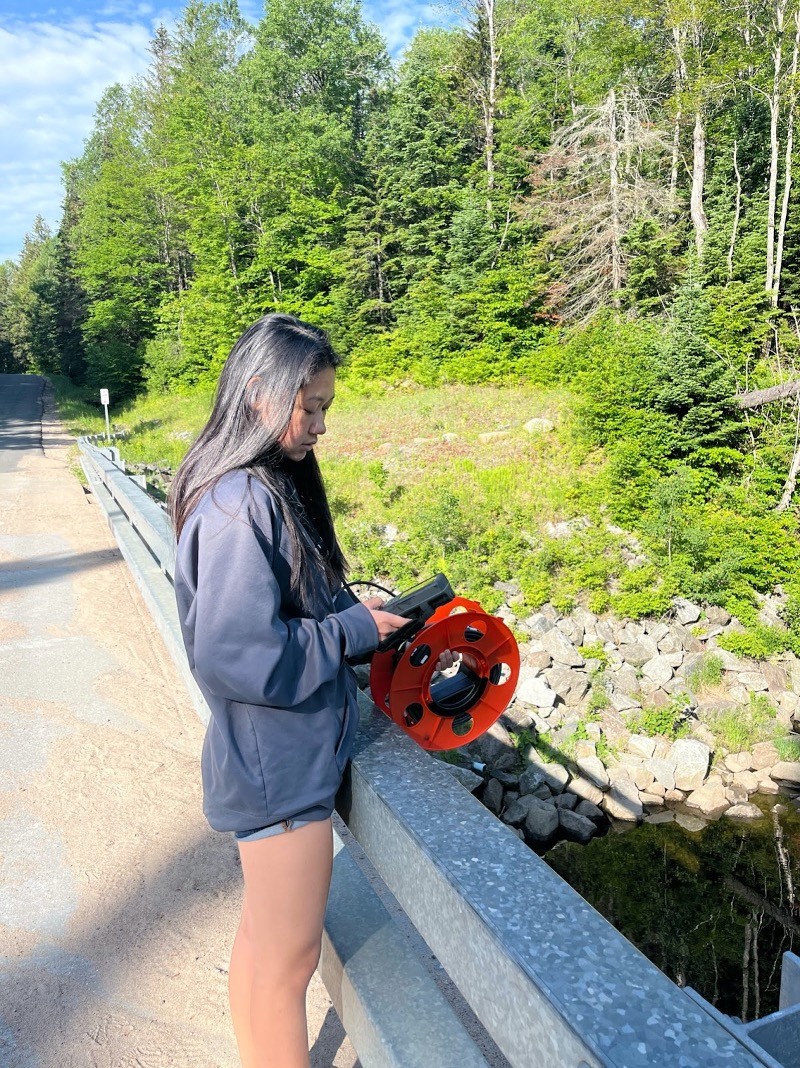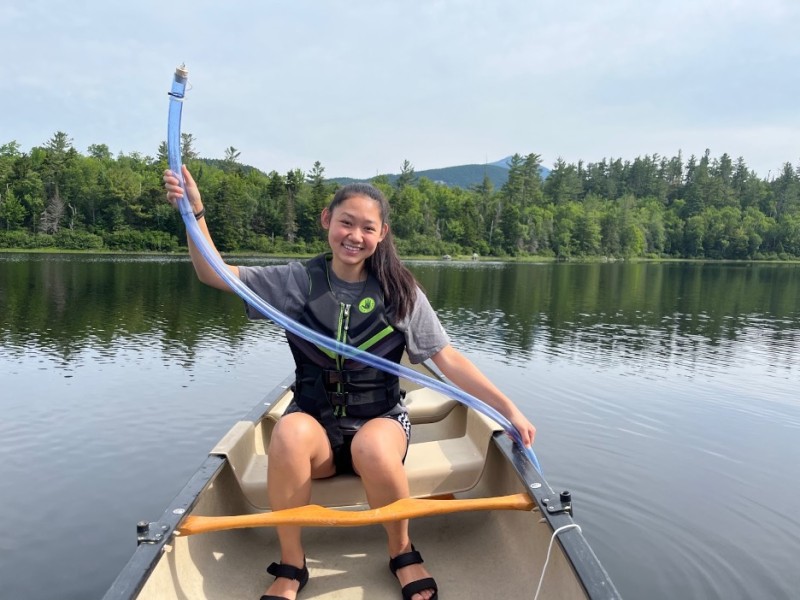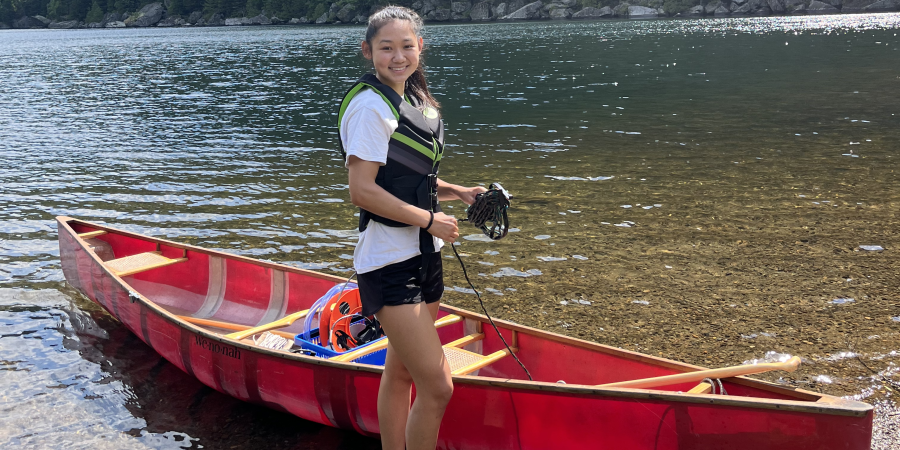When thinking about a standard summer internship, most people might envision a static desk job where they're cooped up inside, staring at a computer screen all day. My experience while interning at the Ausable River Association (AsRA), however, has been worlds apart from that reality, and I proudly boast the tan and mosquito bites to prove it. Working here has given me the opportunity to participate in numerous projects, all revolving around the organization's flagship programs on clean water, healthy streams, and biodiverse habitats. In addition, I've been able to interact with and learn from the local community through events and my everyday work. Each day at AsRA is guaranteed to bring something new and exciting. Here's a glimpse of what a day in the life of an AsRA intern might look like.
Water Quality Monitoring:
The Ausable watershed is composed of numerous lakes and the river is fed by over 70 tributary streams. It allows for an array of diverse organisms to thrive in the ecosystem and gives rise to copious opportunities for recreation. Protecting water quality ensures that both humans and other species can continue to flourish. One way AsRA achieves this is through the monitoring of 30 unique stream sites in the watershed. The streams are monitored biweekly throughout the year, and the data retrieved is compiled into a database that began in 2015. If you happened to be driving around the watershed this summer and noticed someone pulled over to the side of the road, casually lowering a long, wired instrument off a bridge and staring directly down into the water, it was likely me checking the quality of the water. The instrument used is called a YSI ProDSS handheld sonde and the main parameters recorded are temperature, pH, specific conductivity, and dissolved oxygen. For sensitive species such as brook trout, that can only survive in certain temperatures, pH ranges, and dissolved oxygen concentrations, using this data to analyze long-term trends in streams can be helpful in determining if bodies of water will still provide habitat in the face of climate change and increased anthropogenic activity.

Cat lowering the YSI into a stream and logging the data onto the handheld sonde. The data is then downloaded and compiled into the Ausable watershed's water quality database.
In addition, AsRA also monitors a handful of public and private lakes on a monthly basis throughout the months of May-October (with the exception of Mirror Lake which is monitored year-round). When monitoring the water quality for lakes and ponds, the YSI instrument is lowered at 0.5 or 1.0 meter increments at the deepest point of the water to log the parameters noted above throughout the entire water column. In addition, surface and/or bottom samples of the water are collected and sent to a lab to analyze various nutrients and minerals in the water such as phosphorus, nitrogen, or chloride. Lastly, surface water is filtered and analyzed in a lab to determine chlorophyll concentrations in each body of water. The data is available by request and can be obtained by contacting AsRA. Canoeing out to the deepest points of these lakes and ponds with all our equipment can be the most fun or the most challenging (think wind) part of the day. Yet, being able to embrace the pristine beauty of the Adirondacks while out on the water is always a rewarding perk of the job.
Support our water quality work for clean water. Give with confidence today!

Cat holding up an integrated sample that is used to take water samples from lakes. The tube is two meters in length and weighted to ensure that a long stretch of the water column is sampled.
Click here to read prior annual reports on the water quality of Mirror Lake
Biodiverse Habitats: Environmental DNA
For the second year in a row now, AsRA has been working on a project to test the efficacy of eDNA (environmental DNA) methods as compared to conducting fish surveys via electrofishing. Collecting data through eDNA can be an extremely powerful tool as it allows researchers to detect the presence of certain fish species within a kilometer of stream length above the detection site by magnifying trace amounts of DNA left behind by the fish in the water. This is done by filtering five liters of stream water through filter paper then analyzing the contents of the paper in a lab. For this project, we focused on the presence of brook trout and Atlantic salmon, two species that play vital roles in the Ausable and Boquet watersheds.
One of the most common methods used today to quantify the number of fish of a certain species in a stretch of water is electrofishing. This method entails placing an electric probe into the water and sending out an electric current into the water. The voltage sent out is just enough to temporarily stun any nearby fish, and once they are stunned, they float up to the surface, are picked up by a net, identified, processed if they are the target species, then released - safe from harm. While effective, this method requires more time and people power to be able to identify the presence of certain species in a stream than eDNA methods. Electrofishing field days are spent wading around large stretches of a rocky river to reach specifically chosen sites, staying alert to net any and all passing fish, and setting up a filtration system on riverbanks to gather eDNA. They require a highly motivated and enthusiastic team like the one I worked with - who encouraged me no matter how bad I was at netting the fish initially. In partnership with members from the U.S. Fish and Wildlife Service, the Nature Conservancy, and the NYS DEC, experts and rookies alike worked together efficiently and precisely. Quantifying certain fish species through eDNA methods is relatively novel and, if proven to be as effective as manually capturing and counting the fish via electrofishing, it holds immense potential in the scientific realm.
An Ambassador for the Ausable: Farmer’s Markets
If you ever find yourself in Wilmington on a Wednesday in the summer, consider stopping by the Wilmington Farmers Market located on the green just outside of the Riverside Thrift Store right on the West Branch Ausable River. From 9am to 1pm you can enjoy live music brought to you by local musicians, snack on fresh fruits and vegetables at the farm stand, eat delicious pastries and desserts from nearby bakers, marvel at handcrafted arts from Adirondack artisans, and of course, learn more about the wonderful Ausable River that people come from all over the country to fish, swim, paddle, and relax on. Join me at the Ausable River Association’s table for questions or comments on anything and everything related to the organization. Here you can learn all about the work we do, upcoming events we’re hosting, give feedback on things you’ve noticed, and donate to our work dedicated to preserving the river for the benefit of the people and organisms within it.
With just two weeks remaining, there is still far more to be done but I can definitely say I’ve learned a lot. From speaking to anglers when conducting angler surveys who tell me they love this river and take precautions to ensure it stays healthy, to paddling for an hour while battling high winds to take lake samples, it is clear to me that AsRA is committed to taking direct action to protect the Ausable watershed. With your support, we hope to sustain not only the unique and diverse organisms that rely on a clean environment, but also the local community whose lives are deeply connected to the health of the Ausable River.
Story by Cat Wang, Colgate University Upstate Summer Field School 2022 Intern.
Sign-up for our e-newsletter to get weekly updates on the latest stories from the Ausable River Association.





